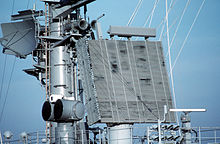AN / SPS-48
The AN / SPS-48 is a three-dimensional airspace search radar with a long range. It is used by the US Corporation ITT Gilfillan produced.
development
Since the AN / SPS-39 could not provide a sufficiently precise fire control solution for the RIM-8 Talos guided weapon, the development of the AN / SPS-48 was commissioned. The manufacturing contract for the first two systems was signed in 1960. The first SPS-48 was installed on the USS Worden in March 1965.
description
The SPS-48 uses the so-called "Frequency scanning" technology (FRESCAN) to find the height of radar targets. A wide range of frequencies is used for transmission. A “scan” process starts at a high frequency, which results in the radar signals being sent from the lower part of the antenna. The frequency is now reduced and the location of the radiation moves upwards on the antenna surface. This changes the angle to the radar target, from which its height can ultimately be calculated. Although this method has the advantage that it does not require any additional mechanical components for height finding and has a higher EloGM resistance, a relatively large and bulky antenna is also required to ensure precise location. Furthermore, several EloGM operating modes and an IFF system are integrated.
variants

SPS-48A-D
- SPS-48A: Original system
- SPS-48B: Unknown. Possibly an unrealized prototype for the C variant
- SPS-48C: Variant with automatic target acquisition and tracking as well as an MTI mode
- SPS-48D: Prototype for the SPS-48E
SPS-48E
The E version is a massive and comprehensive increase in performance based on the C version. The system was tested in 1982 as part of the " New Threat Upgrade " program on board the USS Mahan and delivered from 1986. In the US Navy , the SPS-48E has replaced the majority of the older variants as well as all AN / SPS-52 systems. The unit price is approximately 18 million US dollars. The following is a list of the improvements made:
- Improved antenna (higher sensitivity, lower side lobes )
- Additional splinter protection for the antenna
- Doubling the transmission power
- Use of digital system components with extensive self-diagnostic functions
- Halving of the required components compared to the C variant (increased reliability)
- Increased ECCM capacities
- The radar can also be controlled via external systems (e.g. through the Aegis combat system )
- Improvement of the interfaces. The following weapon systems can be supplied with target data:
- Improved tracking and tracking of the following goals:
- Low-flying aircraft
- Supersonic targets
- Cruise missiles
- helicopter
- Ballistic missiles (up to 300 km altitude)
SPS-48F-G
- SPS-48F: A lighter and more compact version for use on smaller ships. Also has new, more reliable assemblies.
- SPS-48G: This variant, which is offered by ITT, is primarily intended to increase reliability and simplify maintainability.
Upgrades
- Pulse Doppler Upgrade: This upgrade improves Doppler signal processing, thereby increasing performance in coastal waters. Even small objects such as cruise missiles can now be detected with a much higher probability (90% per revolution).
- Solid-State Transmitter: The use of new digital components should further increase the performance and, above all, the reliability of the system.
- Lightweight Antenna: A lighter antenna should be used as part of this upgrade.
Platforms
- Cruisers: Virginia-Class , Leahy-Class , Belknap-Class , California-Class , USS Long Beach , USS Bainbridge , USS Truxtun
- Destroyers: Farragut-class , Forrest-Sherman-class , Kidd-class
- Aircraft Carriers: Nimitz-Class , Forrestal-Class , Midway-Class , USS John F. Kennedy , USS Enterprise
- Amphibious warfare ships: Wasp-class , Tarawa-class , San Antonio-class
Technical specifications
- Weight (above / below deck; SPS-48C): 2,250 kg / 8,750 kg
- Antenna dimensions (W × H): 5.36 m × 5.18 m
- Frequency range : 2.9 - 3.1 GHz
- Polarization : vertical
- Antenna groups:
- SPS-48E: 95
- SPS-48F: 71
-
Pulse power
- SPS-48E: 0.06, 0.66 or 2.4 MW
- SPS-48F: 0.66 MW
- Average performance:
- SPS-48C: 15 kW
- SPS-48E: 18 - 31 kW
- SPS-48F: 15 kW
- Opening angle : 1.5 ° × 1.6 °
- Vertical coverage:
- Search mode: 0 ° - 45 °
- Tracking mode: 0 ° - 69 °
- Pulse repetition frequency : 330 - 2250 Hz
- Transmission time: 2, 9 or 27 µs
- Distance resolution: 0.21 - 0.48 km (0.11 km for E variant)
- Angular resolution : 0.17 °
- Antenna rotation time: 4 - 8 s
- Antenna gain : 38.5 dB
- Range:
- Maximum: 460 km (target search), 925 km (target tracking)
- Fighter aircraft: 445 km
- 5 m² target (see RCS ): 408 km (F variant: 278 km)
- 1 m² goal: 231 km
- 0.1 m² target (in low flight ): 32 km (F variant: 167 km, no low flight)
- Detection probability per cycle: 50% (with PDU upgrade: 90%)
- False alarm probability per cycle: 0.000001%
- Maximum detection height (for E variant):
- Destination search: 30 km
- Target tracking:> 460 km
- Number of trackable targets:> 1000 (E variant)
-
MTBF :
- SPS-48E:> 650 hours
- SPS-48F: 950 hours
- MTTR : 15 minutes (E variant)
Web links
- Federation Of American Scientists
- The Warfighter's Encyclopedia ( Memento of November 5, 2004 in the Internet Archive )
- Manufacturer's product description
